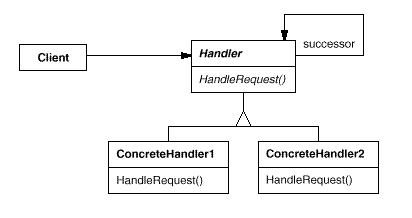索引
意图
结构
参与者
适用性
效果
相关模式
实现
实现方式(一):实现后继者链。
意图
使多个对象都有机会处理请求,从而避免请求的发送者和接收者之间的耦合关系。
将这些对象连成一条链,并沿着这条链传递该请求,直到有一个对象处理它位置。
Avoid coupling the sender of a request to its receiver by giving more than one object a chance to handle the request.
Chain the receiving objects and pass the request along the chain until an object handles it.
结构
一个典型的对象结构可能如下图所示:
参与者
Handler
定义一个处理请求的接口。
实现后继链
ConcreteHandler
处理它所负责的请求。
可访问它的后继者。
如果可处理该请求,就处理;否则将该请求转发给它的后继者。
Client
向链上的具体处理者对象提交请求。
适用性
在以下情况下可以使用 Chain of Responsibility 模式:
有多个对象可以处理一个请求,哪个对象处理该请求运行时自动确定。
你想在不明确指定接收者的情况下,向多个对象中的一个提交一个请求。
可处理一个请求的对象集合应被动态指定。
效果
降低耦合度。对象无需知道哪个一个对象处理其请求,仅需知道对象被处理。
增强了给对象指派职责的灵活性。可以运行时对该链进行动态增加或修改。
相关模式
Chain of Resposibility 常与 Composite 一起使用。一个构件的父构件可作为它的后继。
实现
实现方式(一):实现后继者链。
1 namespace ChainOfResponsibilityPattern.Implementation1 2 { 3 public enum RequestCategory 4 { 5 Category1, 6 Category2, 7 } 8 9 public abstract class Request 10 { 11 public abstract RequestCategory Category { get; } 12 public bool IsHandled { get; set; } 13 } 14 15 public class ConcreteRequest1 : Request 16 { 17 public override RequestCategory Category 18 { 19 get { return RequestCategory.Category1; } 20 } 21 } 22 23 public class ConcreteRequest2 : Request 24 { 25 public override RequestCategory Category 26 { 27 get { return RequestCategory.Category2; } 28 } 29 } 30 31 public abstract class Handler 32 { 33 private Handler _successor; 34 35 public Handler() 36 { 37 } 38 39 public Handler(Handler successor) 40 { 41 _successor = successor; 42 } 43 44 public void Handle(Request request) 45 { 46 OnHandle(request); 47 48 if (!request.IsHandled) 49 { 50 if (_successor != null) 51 { 52 // pass request to successor 53 _successor.Handle(request); 54 } 55 } 56 } 57 58 protected abstract void OnHandle(Request request); 59 } 60 61 public class ConcreteHandler1 : Handler 62 { 63 public ConcreteHandler1() 64 { 65 } 66 67 public ConcreteHandler1(Handler successor) 68 : base(successor) 69 { 70 } 71 72 protected override void OnHandle(Request request) 73 { 74 if (request.Category == RequestCategory.Category1) 75 { 76 // handle the request which category is Category1 77 request.IsHandled = true; 78 } 79 } 80 } 81 82 public class ConcreteHandler2 : Handler 83 { 84 public ConcreteHandler2() 85 { 86 } 87 88 public ConcreteHandler2(Handler successor) 89 : base(successor) 90 { 91 } 92 93 protected override void OnHandle(Request request) 94 { 95 if (request.Category == RequestCategory.Category2) 96 { 97 // handle the request which category is Category2 98 request.IsHandled = true; 99 }100 }101 }102 103 public class Client104 {105 public void TestCase1()106 {107 Request request1 = new ConcreteRequest1();108 Request request2 = new ConcreteRequest2();109 110 Handler handler2 = new ConcreteHandler2();111 Handler handler1 = new ConcreteHandler1(handler2);112 113 handler1.Handle(request1);114 handler1.Handle(request2);115 }116 }117 }《设计模式之美》为 Dennis Gao 发布于博客园的系列文章,任何未经作者本人同意的人为或爬虫转载均为耍流氓。
共同学习,写下你的评论
评论加载中...
作者其他优质文章








